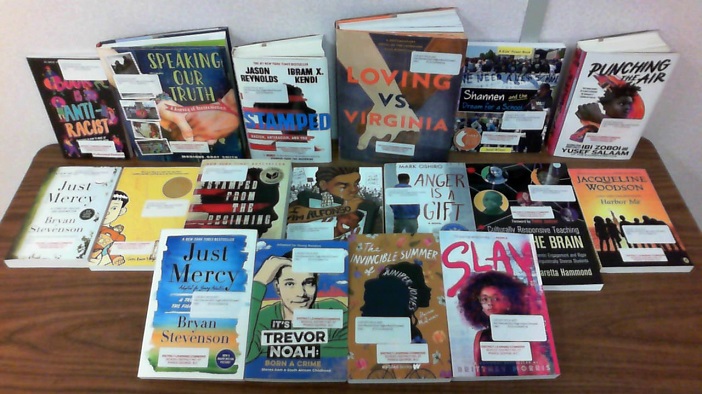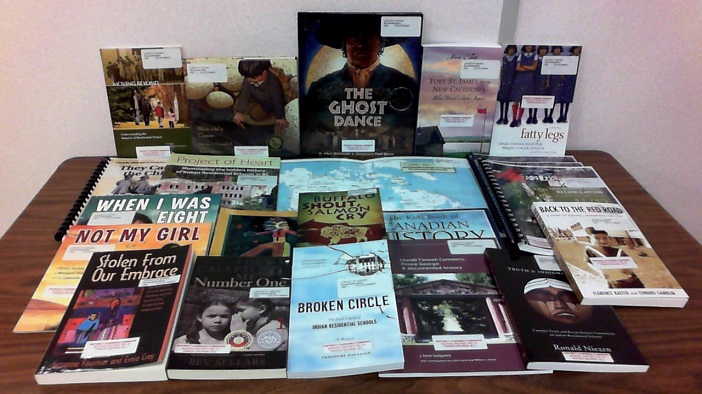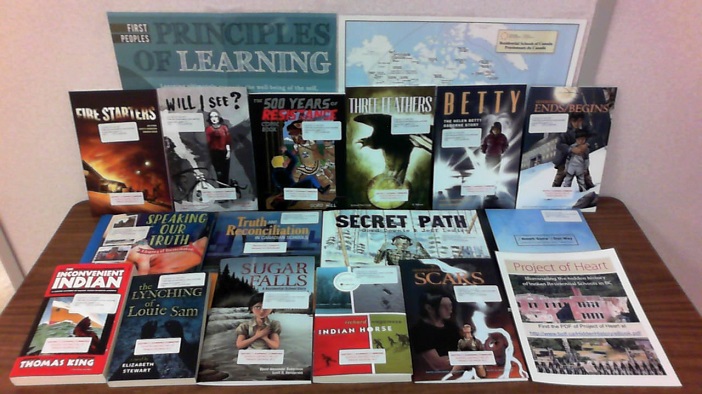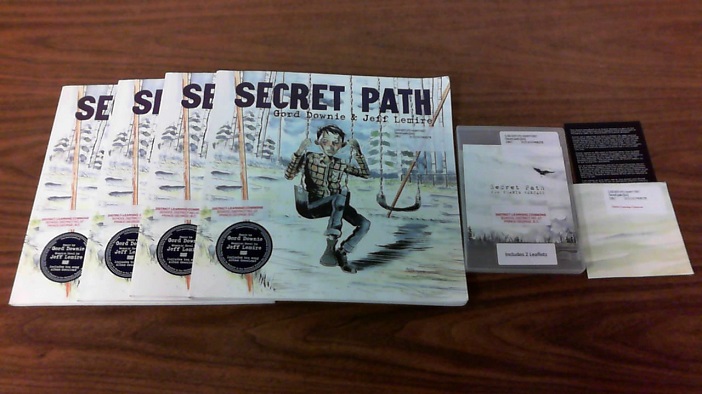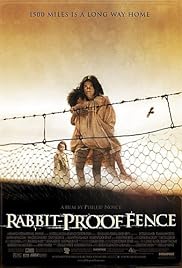Foundational Resources
These resources are foundational to teaching EFP 10-12 and should be viewed first as a primer.
- FNESC/FNSA English First Peoples 10-12 Teacher Resource Guide (2018)
 The FNESC/FNSA English First Peoples 10-12 Teacher Resource Guide (2018) is designed provide support for the British Columbia’s English First Peoples 10-12 curriculum. It includes diverse units, lessons and activities to support the revised EFP 10-12 and ELA 10-12 curriculum using dynamic, rich written, oral, visual, and digital First Peoples literature/text, and reflects evolving educational practice.
The FNESC/FNSA English First Peoples 10-12 Teacher Resource Guide (2018) is designed provide support for the British Columbia’s English First Peoples 10-12 curriculum. It includes diverse units, lessons and activities to support the revised EFP 10-12 and ELA 10-12 curriculum using dynamic, rich written, oral, visual, and digital First Peoples literature/text, and reflects evolving educational practice.
Resources that support these lessons are noted where applicable. - Dakelh Holistic Learning ModelDakelh Ways of Knowing and Enduring Understandings. These were compiled from personal conversations with Elders and community members engaged in Community Curriculum Consultation meetings held on February 21st and March 7th, 2013 in SD57.
Lesson Plan Templates:
- Indigenous Education Unit Plan TemplateA unit plan template that includes areas for recording connections to culturally responsive teaching and the Dakelh Holistic Lifelong Learning model. Developed by K. MacDonald from SD57's Indigenous Education Department.
- Indigenous Education Lesson Plan TemplateA lesson plan template that includes areas for recording connections to culturally responsive teaching and the Dakelh Holistic Lifelong Learning model. Developed by K. MacDonald from SD57's Indigenous Education Department.
BC Curriculum:
 To filter items for just those tagged as authentic Indigenous Voice click on the header.
To filter items for just those tagged as authentic Indigenous Voice click on the header.To sort items by title click on the first column header
Local Resources
 Books with links to local Indigenous groups including Lheidli, McCleod Lake and Simpcw.
Books with links to local Indigenous groups including Lheidli, McCleod Lake and Simpcw.
Go to Local Resources
Novels
 Novels with strong Indigenous content that provide a variety of perspectives and content areas.
Novels with strong Indigenous content that provide a variety of perspectives and content areas.
Go to Novels
Non-Fiction
 Non-Fiction with strong Indigenous content that provide a variety of perspectives and content areas.
Non-Fiction with strong Indigenous content that provide a variety of perspectives and content areas.
Plays
Kits
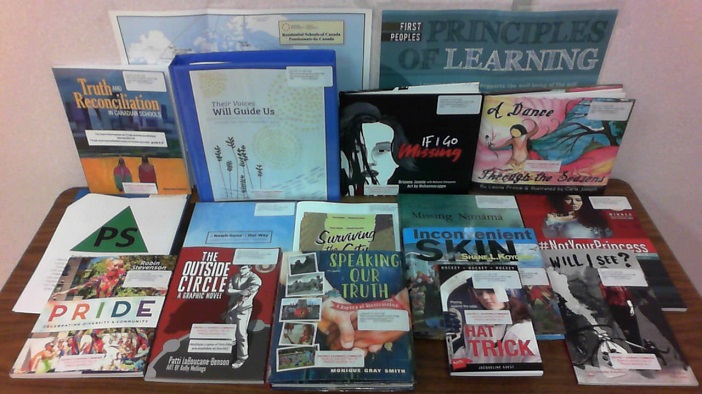
Web Resources

Go to Web Resources
Physical Video Resources
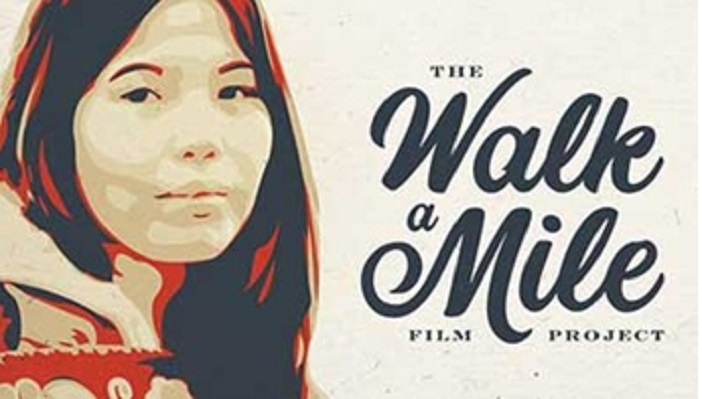
Digital Video Resources

Local Resources
| Title | Description | Subjects | Indigenous Voice |
|---|---|---|---|
|
The Carrier, My People |
Provides a biographical look at the Carrier people. Their history and customs are explored through the experiences of one family. | Dakelh (Carrier), history, biography | |
|
The Carrier of Long Ago |
An overview of Carrier cultural practices, dialects, seasonal focuses, and ways of knowing from a historical perspective. Published by School District No. 57 in 1992 with contributions from various district departments and Elders, as well as the Yinka Dene Language Institute, the Carrier Sekani Tribal Council, and the community. | Dakelh (Carrier), history, culture, language | |
|
Stoney Creek Woman |
The extraordinary story of Mary John, an Indigenous mother of twelve and member of the Carrier band living on the Stoney Creek reserve in central B.C. As told to Bridget Moran, Mary John recounts the hardships endured by her people —racism, sickness, poverty—and above not only these indignities, above not only these indignities, but those she faced as an independent, strong-willed Indigenous woman. In 1997, she was awarded the Order of Canada | Dakelh (Carrier), history, culture, racism | |
|
Judgement at Stoney Creek
|
A look at the investigation into the hit-and-run death of Coreen Thomas, a young Indigenous woman in her ninth month of pregnancy, at the wheels of a car driven by a young white man in central BC. The resulting inquest into what might have been just another small-town tragedy turned into an inquiry of racial tensions, both implicit and explicit, that surfaced not only on country backroads but in the courtroom as well, revealing a dual system of justice that treated whites and Indigenous peoples differently. First published in 1990, Judgement at Stoney Creek has been hailed for its moving and deeply personal depiction of a controversial subject that continues to make news today--how the justice system has failed Canada's Indigenous people. | Criminal justice, justice system, Dakelh (Carrier), racism |
Novels and Graphic Novels
| Title | Description | Recommended Grade(s) | Subjects | Indigenous Voice |
|---|---|---|---|---|
|
This Place, 150 Years Retold |
Explore the past 150 years through the eyes of Indigenous creators in this groundbreaking graphic novel anthology. Beautifully illustrated, these stories are an emotional and enlightening journey through Indigenous wonderworks, psychic battles, and time travel. See how Indigenous peoples have survived a post-apocalyptic world since contact | 10 | Retelling history, short stories, graphic novel | |
|
Nobody Cries at Bingo
|
In Nobody Cries At Bingo, the narrator, Dawn, invites the reader to witness first hand Dumont family life on the Okanese First Nation. Beyond the sterotypes and clichés of Rez dogs, drinking, and bingos, the story of a girl who loved to read begins to unfold. It is her hopes, dreams, and indomitable humour that lay bear the beauty and love within her family. It is her unerring eye that reveals the great bond of family expressed in the actions and affections of her sisters, aunties, uncles, brothers, cousins, nieces, nephews, and ultimately her ancestors. It’s all here — life on the Rez in rich technicolour — as Dawn emerges from home life, through school life, and into the promise of a great future. Nobody Cries At Bingo embraces cultural differences and does it with the great traditional medicine of laughter Recommended English First Peoples resource for grades 11-12 in the unit What Creates Family. |
11, 12 | Okanese, Family | |
|
Motorcycles & Sweetgrass
Available in SD57 DLC (1 copy) |
Otter Lake is a sleepy Anishnawbe community where little happens. Until the day a handsome stranger pulls up astride a 1953 Indian Chief motorcycle – and turns Otter Lake completely upside down. Maggie, the Reserve’s chief, is swept off her feet, but Virgil, her teenage son, is less than enchanted. Suspicious of the stranger’s intentions, he teams up with his uncle Wayne – a master of aboriginal martial arts – to drive the stranger from the Reserve. And it turns out that the raccoons are willing to lend a hand. Grades 11-12 BC English First Peoples resource for the unit What Creates Family? |
11, 12 | Anishinaabeg, Family, Small Town Life | |
|
The Missing |
Feather is determined to find a missing friend despite the lack of police interest in this disappearance or any of the previous ones that resulted in deaths |
10, 11, 12 | Discrimination in criminal justice, Missing persons, Crimes against Indigenous peoples | |
|
Son of a Trickster |
Everyone knows a guy like Jared: the burnout kid in high school who sells weed cookies and has a scary mom who's often wasted and wielding some kind of weapon. Jared does smoke and drink too much, and he does make the best cookies in town, and his mom is a mess, but he's also a kid who has an immense capacity for compassion and an impulse to watch over people more than twice his age, and he can't rely on anyone for consistent love and support, except for his flatulent pit bull, Baby Killer (he calls her Baby)—and now she's dead. Jared can't count on his mom to stay sober and stick around to take care of him. He can't rely on his dad to pay the bills and support his new wife and step-daughter. Jared is only sixteen but feels like he is the one who must stabilize his family's life, even look out for his elderly neighbours. But he struggles to keep everything afloat... and sometimes he blacks out. And he puzzles over why his maternal grandmother has never liked him, why she says he's the son of a trickster, that he isn't human. Mind you, ravens speak to him—even when he's not stoned. You think you know Jared, but you don't. Grades 11-12 BC English First Peoples resource for the unit What Creates Family. |
11, 12 |
Substance abuse, dysfunctional families, Tricksters legends. Mature Content Warning: This novel contains mature subject matter such as drug use and depictions of sex and violence. |
|
|
The Absolutely True Diary of a Part-Time Indian
|
In his first book for young adults, bestselling author Sherman Alexie tells the story of Junior, a budding cartoonist growing up on the Spokane Indian Reservation. Determined to take his future into his own hands, Junior leaves his troubled school on the rez to attend an all-white farm town high school where the only other Indian is the school mascot. Heartbreaking, funny, and beautifully written, The Absolutely True Diary of a Part-Time Indian, which is based on the author's own experiences, coupled with poignant drawings by Ellen Forney that reflect the character's art, chronicles the contemporary adolescence of one Native American boy as he attempts to break away from the life he was destined to live. |
10 |
Teenage life, Art, Life off reserve Mature Content Warning: Strong language |
|
|
Indian Horse |
Saul Indian Horse has hit bottom. His last binge almost killed him and now he's a reluctant resident in a treatment centre. But Saul wants peace and he realizes that he'll only find it through telling his story. Beginning with his childhood on the land, he embarks on a journey through his life as a northern Ojibway, with all its joys and sorrows. Grades 10-12 BC English First Peoples resource for units on Lost People, Reconciliation, and Place-Conscious Learning. |
10, 11, 12 | Ojibwa, Substance Abuse | |
|
7 Generations: A Plains Cree Saga |
Seven generations: a plains Cree saga follows one Plains Cree family from the 19th century to the present day. For Edwin, the story of his ancestors from both the distant and recent past must guide him through an uncertain present, to the dawn of a new future. Originally published as a four-part graphic novel series, 7 Generations explores the life of Stone, a young cree warrior, the smallpox epidemic of 1870, the residential school system of the 20th century and its familial legacy.
Also available in 4 separate graphic novels |
10, 11, 12 | Cree, Graphic Novels, Indigenous History, Residential Schools, Smallpox epidemic, families | |
|
Jonny Appleseed
|
Winner of 2021 Canada Reads.
"You're gonna need a rock and a whole lotta medicine" is a mantra that Jonny Appleseed, a young Two-Spirit/Indigiqueer, repeats to himself. Off the reserve and trying to find ways to live and love in the big city, Jonny becomes a cybersex worker who fetishizes himself in order to make a living. Self-ordained as an NDN glitter princess, Jonny has one week before he must return to the "rez"--and his former life--to attend the funeral of his stepfather. The seven days that follow are like a fevered dream: stories of love, trauma, sex, kinship, ambition, and the heartbreaking recollection of his beloved kokum (grandmother). Jonny's life is a series of breakages, appendages, and linkages--and as he goes through the motions of preparing to return home, he learns how to put together the pieces of his life. Jonny Appleseed is a unique, shattering vision of First Nations life, full of grit, glitter, and dreams. |
12 |
Two-spirit, Indigiqueer, LGTBQ+, home and family, trauma Mature Content Warning: Strong sexual language used. |
|
|
The 500 Years of Resistance Comic Book |
A bombastic look at the history of Indigenous resistance to colonialism from protests to landgrabs, pipelines, water contamination and other injustices this retelling of history pulls no punches with its look at the history of Indigenous relations in North America. | 11, 12 | Retelling history, Indigenous resistance, colonialism, graphic novels, government relations | |
|
Marrow Thieves |
In a future world ravaged by global warming, people have lost the ability to dream, and the dreamlessness has led to widespread madness. The only people still able to dream are North America's indigenous population - and it is their marrow that holds the cure for the rest of the world. But getting the marrow - and dreams - means death for the unwilling donors. Driven to flight, a 15-year-old and his companions struggle for survival, attempt to reunite with loved ones, and take refuge from the "recruiters" who seek them out to bring them to the marrow-stealing 'factories.'” | 10 |
Global warming, Indigenous Science Fiction, Dystopia Mature Content Warning: This book touches on physical and sexual violence. |
|
|
Hunting by Stars: A Marrow Thieves Novel |
French has been captured by the Recruiters, confined to one of the infamous residential schools, where the government extracts the marrow of Indigenous people in order to steal the ability to dream, and where the captured are programmed to betray others of their kind, something which he discovers has been done to his brother; meanwhile the other survivors, his found family, are hunting for him, determined to rescue him—and French has to decide just how much, and whom, he is willing to sacrifice to survive and be reunited with Rose and the others | 10 |
Global warming, Indigenous Science Fiction, Dystopia Mature Content Warning: This book touches on physical and sexual violence. |
|
|
Grey Eyes |
In a world without time and steeped in ceremony and magic, walks a chosen few who hold an ancient power: the Grey Eyes. True stewards of the land, the Grey Eyes use their magic to maintain harmony and keep evil at bay. With only one elderly Grey-Eye left in the village of the Nehiyawak, the birth of a new Grey-Eyed boy promises a renewed line of defence against their only foe: the menacing Red-Eyes, whose name is rarely spoken but whose presence is ever felt. While the birth of the Grey-Eyed boy offers the clan much-needed protection, it also initiates a struggle for power that threatens to rip the clan apart, leaving them defenceless against their sworn enemy. The responsibility of restoring balance and harmony, the only way to keep the Nehiyawak safe, is thrust upon a boy's slender shoulders. What powers will he have, and can he protect the clan from the evil of the Red Eyes? | 11, 12 | Indigenous fantasy | |
|
Medicine Walk |
Tells the universal story of a father/son struggle in a fresh, utterly memorable way, set in the dramatic landscape of the BC Interior. Franklin Starlight is called to visit his father, Eldon. He's 16 years old and has had the most fleeting of relationships with the man. The rare moments they've shared haunt and trouble Frank, but he answers the call, a son's duty to a father. He finds Eldon decimated after years of drinking, dying of liver failure. Eldon asks his son to take him into the mountains, so he may be buried in the traditional Ojibway manner. Grades 10-12 BC English First Peoples resource for units on Childhood, Place-Conscious Learning, and Family. |
10, 11, 12 | Ojibwa, Rdemption, Father-son dynamics, teenage life | |
|
Missing Nimama |
Kateri is a young girl, growing up in the care of her grandmother. We see her reaching important milestones her first day of school, first dance, first date, wedding, first child along with her mother, who is always there, watching her child growing up without her. Told in alternating voices, Missing Nimâmâ is a story of love, loss, and acceptance, showing the human side of a national tragedy. | 10 | Dual-language (English & Cree), Illustrated novels, family life, Murdered and missing Indigenous women and girls. | |
|
The Outside Circle |
Pete, a young Indigenous man wrapped up in gang violence, lives with his younger brother, Joey, and his mother who is a heroin addict. One night, Pete and his mother's boyfriend, Dennis, get into a big fight, which sends Dennis to the morgue and Pete to jail. Initially, Pete keeps up ties to his crew, until a jail brawl forces him to realize the negative influence he has become on Joey, which encourages him to begin a process of rehabilitation that includes traditional Indigenous healing circles and ceremonies. Powerful, courageous, and deeply moving, The Outside Circle is drawn from the author's twenty years of work and research on healing and reconciliation of gang-affiliated or incarcerated Indigenous men. | 10, 11, 12 | Gangs, Rehabilitation, Crime, Healing Circles, Graphic Novel | |
|
Tilly
|
Tilly has always known she’s part Lakota on her dad’s side. She’s grown up with the traditional teachings of her grandma, relishing the life lessons of her beloved mentor. But it isn’t until an angry man shouts something on the street that Tilly realizes her mom is Aboriginal too―a Cree woman taken from her own parents as a baby. Tilly feels her mother’s pain deeply. She’s always had trouble fitting in at school, and when her grandma dies unexpectedly, her anchor is gone. Then Abby, a grade-seven classmate, invites her home for lunch and offers her “something special” to drink. Nothing has prepared Tilly for the tingling in her legs, the buzz in her head and the awesome feeling that she can do anything. From then on, partying seems to offer an escape from her insecurities. But after one dangerously drunken evening, Tilly knows she has to change. Summoning her courage, she begins the long journey to finding pride in herself and her heritage. Just when she needs it most, a mysterious stranger offers some wise counsel: “Never question who you are or who your people are. It’s in your eyes. I know it’s in your heart.” Grades 10-12 English First Peoples resource for units on Childhood through the Eyes of Indigenous Writers and Exploring Text through Local Landscape. |
10, 11, 12 | Lakota, Cree, substance abuse, coming of age | |
|
Tilly and the Crazy Eights
|
When Tilly receives an invitation to help drive eight elders on their ultimate bucket-list road trip, she impulsively says yes. Before she knows it, Tilly has said good-bye to her family and is on an adventure that will transform her in ways she could not predict, just as it will for the elders who soon dub themselves “the Crazy Eights.” The Crazy Eights each choose a stop—somewhere or something they’ve always wanted to experience—on the way to their ultimate goal, the Gathering of Nations Pow Wow in Albuquerque. Their plan is to travel to Las Vegas, Sedona, and the Redwood Forests, with each destination the inspiration for secrets and stories to be revealed. The trip proves to be powerful medicine as they laugh, heal, argue, and dream along the way. By the time their bus rolls to a stop in New Mexico, Tilly and the Crazy Eights, with friendships forged and hearts mended, feel ready for anything. But are they? | 10, 11, 12 | Road Trips, Friendship, Elders | |
|
Moonshot Vol 1-3
|
MOONSHOT: The Indigenous Comics Collection brings together dozens of creators from North America to contribute comic book stories showcasing the rich heritage and identity of indigenous storytelling. From traditional stories to exciting new visions of the future, this collection presents some of the finest comic book and graphic novel work on the continent. Volume 3 - Focuses on Indigenous Futurism. The intelligence of those who came before us is to be honoured - for through the eyes of their past we recognize the truth of our present, and are able to envision many possible futures or alternate realities. With this, events created by the authors contained in this Collection are made of a fabric that includes traditions, ancestral memories and the utmost respect. The 15 stories in MOONSHOT Volume 3 will illustrate the Indigenous Futurisms concept in striking, intriguing, dramatic and dynamic ways. Will there be space and time travel? Yes! Will we encounter parallel dimensions? Of course! Advanced technology, post-apocalyptic settings, robots, aliens and more. It's all here! But this is not fantasy, and time is not a straight line with a definitive beginning, middle and end." - From Publisher |
10, 11, 12 |
Graphic Novel, Short Stories, Indigenous Fantasy, Indigenous Science Fiction Mature Content Warning: Some stories have sexual scenes |
|
|
The Barren Grounds
|
Morgan and Eli, two Indigenous children forced away from their families and communities, are brought together in a foster home in Winnipeg, Manitoba. They each feel disconnected, from their culture and each other, and struggle to fit in at school and at their new home -- until they find a secret place, walled off in an unfinished attic bedroom. A portal opens to another reality, Askí, bringing them onto frozen, barren grounds, where they meet Ochek (Fisher), the only hunter supporting his starving community | 10 (lower readers) | Indigenous Fantasy, Middle Grade | |
|
The Night Wanderer |
Grades 10-12 BC English First Peoples resource for units on Identity, Place-Conscious Learning, and Relationships. |
10, 11, 12 | Ojibwa, Vampires, Indigenous Gothic Horror | |
|
April Raintree
|
Very few of us have a proper understanding of the tragic and painful circumstances of Indigenous life in urban Canada. A truly black mark on the record of the Canadian government and Canadian society as a whole, these problems are dealt with by the astute and truthful writing of Beatrice Culleton. April Raintree is a work of autobiographical fiction that not only brings the reader into a genuine and difficult aspect of urban life, but also reveals Culleton`s significant talents. | 11, 12 | Urban life, Institutional racism, racism | |
|
Kiss of the Fur Queen
|
Born into a magical Cree world in snowy northern Manitoba, Champion and Ooneemeetoo Okimasis are all too soon torn from their family and thrust into the hostile world of a Catholic residential school. Their language is forbidden, their names are changed to Jeremiah and Gabriel, and both boys are abused by priests. Grade 11/12 English First Peoples resource for the unit Further Steps toward Reconciliation - Understanding Residential Schools through Text. |
11, 12 | Residential School, Tricksters, Child Abuse Mature Subject Warning: This novel contains mature and challenging material (profanity, coarse language, depictions of sex, sexual abuse, violence, etc.). |
|
|
Monkey Beach
Available in SD57 DLC (1 copy) |
Five hundred miles north of Vancouver is Kitamaat, an "Indian reservation" in the homeland of the Haisla people. Growing up a tough, wild tomboy, swimming, fighting, and fishing in a remote village where the land slips into the green ocean on the edge of the world, Lisamarie has always been different. Visited by ghosts and shapeshifters, tormented by premonitions, she can't escape the sense that something terrible is waiting for her. She recounts her enchanted yet scarred life as she journeys in her speedboat up the frigid waters of the Douglas Channel. She is searching for her brother, dead by drowning, and in her own way running as fast as she can toward danger. Circling her brother''s tragic death are the remarkable characters that make up her family: Lisamarie''s parents, struggling to join their Haisla heritage with Western ways; Uncle Mick, an Indigenous rights activist and devoted Elvis fan; and the headstrong Ma-ma-oo (Haisla for "grandmother"), a guardian of tradition. |
11, 12 |
Coming of age, Northern Communities, Family Mature Content Warning: This novel contains mature subject matter such as drug use and depictions of sex and violence. |
|
|
Follow the Rabbit-Proof Fence
|
This extraordinary story of courage and faith is based on the actual experiences of three girls who fled from the repressive life of Moore River Native Settlement, following along the rabbit-proof fence back to their homelands. Assimilationist policy dictated that these girls be taken from their kin and their homes in order to be made white. Settlement life was unbearable with its chains and padlocks, barred windows, hard cold beds, and horrible food. Solitary confinement was doled out as regular punishment. The girls were not even allowed to speak their language. Of all the journeys made since white people set foot on Australian soil, the journey made by these girls born of Indigenous mothers and white fathers speaks something to everyone. | 10, 11, 12 | Australian Indigenous, Residential schools | |
|
Dream Wheels
Available in SD57 DLC (1 copy) |
Cowboy lore and First Nations mysticism in this affecting novel about the healing effects of family. In pursuit of a world-champion title, Joe Willie Wolfchild suffers a horrific, career-ending accident while riding a temperamental bull named C-4. His supportive family, longtime rodeo people, whisk him back to their ranch to recuperate. Far from the laconic stereotype, this book is filled with his soaring descriptions of the desert landscape, action-packed rodeo scenes, and reverence for hearth and home which will strike a chord with readers. Grades 10-11 BC English First Peoples resource for the unit on Relationships. |
10, 11 | Family, Coming of Age | |
|
Three Feathers
|
Three young men -- Flinch, Bryce, and Rupert -- have vandalized their community. They are sent by its Elders to live nine months on the land as part of the circle sentencing process. There, the young men learn to take responsibility for their actions and acquire the humility required to return home. But will they be forgiven for what they have done? Grades 10-12 BC English First Peoples Resource for units on Childhood and Place-Conscious Learning. |
10, 11, 12 | Restorative justice, Northern Communities, Graphic Novel | |
|
Code Talker
|
Throughout World War II, in the conflict fought against Japan, Navajo code talkers were a crucial part of the U.S. effort, sending messages back and forth in an unbreakable code that used their native language. They braved some of the heaviest fighting of the war, and with their code, they saved countless American lives. Yet their story remained classified for more than twenty years. Recommended English First Peoples Resource for grades 10-12 in units on identity; steps toward reconciliation; and exploring text through local landscape |
10, 11, 12 | Navajo, World War II, Code-breaking | |
|
Dreaming In Indian
|
Truly universal in its themes, Dreaming In Indian will shatter commonly held stereotypes and challenge readers to rethink their own place in the world. Divided into four sections, ‘Roots,’ ‘Battles,’ ‘Medicines,’ and ‘Dreamcatchers,’ this book offers readers a unique insight into a community often misunderstood and misrepresented by the mainstream media. | 10, 11, 12 |
Short Stories, Biography, Stereotyping, Community, Racism, Self-esteem, Tolerance |
|
|
Celia's Song
|
Mink is a witness, a shape shifter, compelled to follow the story that has ensnared Celia and her village, on the West coast of Vancouver Island in Nu:Chahlnuth territory. Celia is a seer who - despite being convinced she's a little "off" - must heal her village with the assistance of her sister, her mother and father, and her nephews. While mink is visiting, a double-headed sea serpent falls off the house front during a fierce storm. The old snake, ostracized from the village decades earlier, has left his terrible influence on Amos, a residential school survivor. The occurrence signals the unfolding of an ordeal that pulls Celia out of her reveries and into the tragedy of her cousin's granddaughter. Each one of Celia's family becomes involved in creating a greater solution than merely attending to her cousin's granddaughter. Celia's Song relates one Nu:Chahlnuth family's harrowing experiences over several generations, after the brutality, interference, and neglect resulting from contact with Europeans. Grade 11/12 English First Peoples resource for the unit Further Steps toward Reconciliation. |
11, 12 | Residential Schools, Healing | |
|
Medicine River
|
When Will returns to Medicine River, he thinks he is simply attending his mother's funeral. He doesn't count on Harlen Bigbear and his unique brand of community planning. Harlen tries to sell Will on the idea of returning to Medicine River to open shop as the town's only Native photographer. Somehow, that's exactly what happens. Grade 10/11 English First Peoples resource included in the unit Relationships - Families, Friendships, Communities, and the Land. |
10, 11 | Family, sports, small town life | |
|
Elatsoe
|
A teenager with supernatural gifts must solve her cousin’s murder before it’s too late. Aside from the fact that she owns a ghost dog named Kirby, Ellie is like any other comic book–loving, ice cream–eating Lipan Apache teenager. Her non-Native friends include her childhood buddy Jay, who is White, and her cousin Trevor’s Latinx wife, Lenore. Yet Ellie does have traits that set her apart: She has inherited the talents of Six-Great-Grandmother, her powerful Lipan Apache forebear, and plans to skip college to work as a paranormal investigator. When Trevor dies in what appears to be a car accident, his ghost appears to her briefly, begging that she protect his wife and child. Ellie must call upon her strong lineage to rid her ancestral land of an ancient curse. Even as she discovers some of her own tribal relatives have been complicit in historic wrongdoing, she must save her family, animals, and community from destructive forces and restore balance to the world. A fast-paced whodunit set in a contemporary world like our own, this is a creative fusion of Indigenous cultural influences and supernatural fantasy. A brilliant, engaging debut written by a talented author, it seamlessly blends cyberstalking with Vampire Citizen Centers and Lipan Apache stories. This groundbreaking introduction to the fantasy genre remains relevant to Native histories even as it imaginatively looks to the future.. |
10, 11, 12 | Family, murder-mystery, storytelling, Indigenous Fantasy, Lipan Apache | |
|
A blanket of butterflies (Spirit of Denendeh Volume 1)
|
A Blanket of Butterflies explores the journey of Shinobu, a mysterious stranger who visits Fort Smith, NWT, to retrieve his family's samurai suit of armor and sword from the museum. When he discovers that his grandfather's sword has been lost in a poker game to the man they call "Benny the Bank," he sets out to retrieve it, with the help of a young boy, Sonny, and his grandmother. Together, they face Benny and his men, Torchy, Sfen and the giant they call Flinch.. |
10, 11, 12 | Northwest Territory, Dene, Denendeh, Graphic-Novel | |
|
Surviving the City Series
|
"Tasha Spillet's graphic-novel debut, Surviving the City, is a story about womanhood, friendship, resilience, and the anguish of a missing loved one. Miikwan and Dez are best friends. Miikwan's Anishinaabe; Dez is Inninew. Together, the teens navigate the challenges of growing up in an urban landscape - they're so close, they even completed their Berry Fast together. However, when Dez's grandmother becomes too sick, Dez is told she can't stay with her anymore. With the threat of a group home looming, Dez can't bring herself to go home and disappears. Miikwan is devastated, and the wound of her missing mother resurfaces. Will Dez's community find her before it's too late? Will Miikwan be able to cope if they don't? Colonialism and the issue of Missing and Murdered Indigenous Women, Girls, and Two-Spirit People are explored in Natasha Donovan's beautiful illustrations."-Provided by publisher. |
10, 11, 12 | LGBTQ+, Two-spirit/Indigiqueer, Runaway teen, Urban Indigenaity, Graphic-Novel | |
|
A Girl Called Echo Series
|
"Echo Desjardins, a 13 year-old Métis girl, is struggling with her feelings of loneliness while attending a new school and living with a new foster family. Then an ordinary day in Mr. Bee's history class turns extraordinary and Echo's life will never be the same. During Mr. Bee's lecture, Echo finds herself transported to another time and place—a bison hunt on the Saskatchewan prairie—and back again to the present. In the following weeks, Echo slips back and forth in time. She visits a Métis camp, travels the old fur trade routes, and experiences the perilous and bygone era of the Pemmican Wars. Pemmican Wars is the first graphic novel in a series by Katherena Vermette, Governor General Award winning writer, and author of Highwater Press' The Seven Teaching Stories."-Provided by publisher |
10 | Historical, Metis, Saskatchewan, Pemmican Wars, Red River Rebellion, Louis Riel, Graphic-Novel | |
|
Strangers: Reckoners book 1
|
When Cole Harper is compelled to return to Wounded Sky First Nation, he finds his community in chaos: a series of shocking murders, a mysterious illness ravaging the residents, and reemerging questions about Cole's role in the tragedy that drove him away 10 years ago. With the aid of an unhelpful spirit, a disfigured ghost, and his two oldest friends, Cole tries to figure out his purpose, and unravel the mysteries he left behind a decade ago. Will he find the answers in time to save his community? |
10, 11 | Fantasy, Mystery, Ghosts | |
|
Skraelings
|
When young Inuit hunter Kannujaq comes upon a camp of the rarely seen Tuniit people as it comes under attack by brutal, pale men, he must find out why these strangers keep returning to the Tuniit every spring in their boat shaped like a loon. |
10 | Inuit, Vikings, Historical | |
|
A Theory of Crows
|
"From the award-winning author of Black Water and On the Trapline, in his first novel for adults, the story of an estranged father and daughter who must find their way back to one another. Deep in the night, when Matthew paces the house, unable to sleep, he pauses outside his daughter?s bedroom. Hallelujah, who goes by Holly, is only on the other side of the door, but feels a universe away. He worries about her, a young Cree woman, but cannot seem to bridge the gap between them. Claire claims things would be better if he looked up from his phone or showed up to watch her swim meets like he promised. But Matthew cannot shake an emptiness that is leaving him on the outside of his own life looking in. It?s causing him to make mistakes that have the potential to damage his family forever. And Holly has just figured them out. When a tragedy close to home occurs, Matthew and Holly take an unexpected journey out onto the land to search for a long-lost cabin out on the family trapline. But each of them is searching for something more than a place and what happens in the wilderness will test them in ways they never thought possible. Award-winning author David A Robertson, in his first novel for adults, has created a moving contemporary story exploring the bonds of family, the search for identity and the enduring connection to the land."-Provided by publisher. CAUTIONS: Mature language throughout, suicide, self-harm and self-medication are discussed |
11, 12 | Father and Daughter relationship, anxiety, depression, land-based learning, ancestral memory, Cree, identity | |
|
Keeper'n me
|
Garnet Raven, taken from his Ojibway home at the age of three and placed in a series of foster homes, escapes at the first opportunity, but finds himself adrift in the big city. A lonely, disillusioned, and jailed twenty year-old, he receives a surprise letter from his native family. CAUTIONS: some profanity, drug use, mild sexual innuendo; reading level is approximately grade 10. |
Ojibwa, Foster Children, Prison System | 11, 12 | |
|
Walking in Two Worlds
|
An indigenous teen girl is caught between two worlds both real and virtual in the YA fantasy debut from bestselling Indigenous author Wab Kinew. Bugz is caught between two worlds. In the real world, she's a shy and self-conscious Indigenous teen who faces the stresses of teenage angst and reserve life. But in the virtual world, her alter ego is not just confident but dominant in a massive multiplayer video game universe. Feng is a teen boy who has been sent from China to live with his aunt, a doctor on the reserve, after his online activity suggests he may be developing extremist sympathies. Meeting each other in real life, as well as in the virtual world, Bugz and Feng immediately relate to each other as outsiders and as avid gamers. As their connection is strengthened through their virtual adventures, they find they have much in common in the real world, too: both must decide what to do in the face of temptations and pitfalls, and both must grapple with the impact of family and community trauma. But betrayal threatens everything Bugz has built in the virtual world, as well as her relationships in the real world, and it will take all her newfound strength to restore her friendship with Feng and reconcile the parallel aspects of her life: the traditional and the mainstream, the east and the west, the real and the virtual. |
Video Games, Fantasy, Family | 10 | |
|
He Who Dreams
|
When John discovers dancing, he finds himself facing ridicule from his soccer teammates and hostility from the dancers at the cultural center. To dance at the Pow Wow, he must learn to balance his responsibilities, confront his fears and embrace both the Irish and the Cree sides of his heritage. This is a high interest low vocabulary book. Grade level of reading is approximately grade 3/4 |
Dancing, Gender discrimination, tradition, bullying, Cree | 11, 12 | |
|
Dreaming in Color
|
Jennifer McCaffrey has been working hard on her art for years and is thrilled when she is accepted to a prestigious art school. The school is everything she always thought it would be, mostly. There is one group of kids who seem to resent her and say she only got in because of her skin color. Jen, who loves to create new pieces of artwork that incorporate her Indigenous heritage, finds herself a target when the group tells her to stop being “so Indian”. The night before the big art show at school, Jen’s beading art project is defaced. Jen has to find a way not to let the haters win. This is a high interest low vocabulary book. Grade level of reading is approximately grade 3/4 |
Racism, prejudice, bullying, cultural pride, Indigenous art | 11, 12 |
Non-Fiction Novels
| Title | Description | Rec. Grade(s) | Subjects | Indigenous Voice |
|---|---|---|---|---|
|
Seven Fallen Feathers |
Over the span of ten years, seven high school students died in Thunder Bay, Ontario. The seven were hundreds of miles away from their families, forced to leave their reserve because there was no high school there for them to attend. Award-winning journalist Tanya Talaga delves into the history of this northern city that has come to manifest, and struggle with, human rights violations past and present against aboriginal communities |
11, 12 |
Narrative non-fiction, social conditions, civil rights, government relations, murdered and missing, suicide |
|
|
In This Together: Fifteen Stories of Truth and Reconciliation |
A collection of essays about reconciliation and anti-racism by Indigenous and non-Indigenous contributors from across Canada. |
10, 11, 12 |
Social aspects of reconciliation, government relations, reconciliation, social conditions, history of Canada. |
|
|
Indivisible: Indigenous Human Rights |
Indigenous rights are generally conceptualized and advocated separately from the human rights framework. The contributors to Indivisible: Indigenous Human Rights, however, deftly and powerfully argue that Indigenous rights are in fact human rights and that the fundamental human rights of Indigenous people cannot be protected without the inclusion of their Indigenous rights, which are suppressed and oppressed by the forces of racism and colonialism. Drawing on a wealth of experience and blending critical theoretical frameworks and a close knowledge of domestic and international law on human rights, the authors in this collection show that settler states such as Canada persist in violating and failing to acknowledge Indigenous human rights. Furthermore, settler states are obligated to respect and animate these rights, despite the evident tensions in political and economic interests between elite capitalists, settler citizens and Indigenous peoples. |
11, 12 |
Legal rights of Indigenous peoples, Human rights, Government relations, Canadian laws, Civil rights of Canadians and Indigenous peoples. |
|
|
Betty: The Helen Betty Osborne Story |
Helen Betty Osborne, known as Betty to her closest friends and family, dreamed of becoming a teacher. She left home to attend residential school and later moved to The Pas, Manitoba, to attend high school. On November 13, 1971, Betty was abducted and brutally murdered by four young men. Initially met with silence and indifference, her tragic murder resonates loudly today. Betty represents one of almost 1,200 Indigenous women in Canada who have been murdered or gone missing. This is her story |
10, 11, 12 |
Murdered and missing Indigenous women, Crimes |
|
|
The Chilcotin War |
This colourful account of the Chilcotin War is an insightful and absorbing examination of an event that helped to shape the course of British Columbia history. In the spring of 1864, 14 men building a road along the Homathko River in British Columbia were killed by a Tsilhqot’in (Chilcotin) war party. Other violent deaths followed in the conflict that became known as the Chilcotin War. In this true tale of clashing cultures, greed, revenge and betrayal, Rich Mole explores the causes and deadly consequences of a troubling episode in British Columbia history that is still subject to debate almost 150 years later. Using contemporary sources, Mole brings to life the principal players in this tragic drama: Alfred Waddington, the Victoria businessman who decided to build the ill-fated toll road across the territory of the independent Tsilhqot’in, attempting to connect Bute Inlet to the Cariboo goldfields of the interior, and Klatsassin, the fierce Tsilhqot’in war chief whose people had already endured the devastation of smallpox. |
12 |
Tsilhqot’in (Chilcotin), Chilcotin war, history |
|
|
They Called Me Number One |
Xat'sull Chief Bev Sellars spent her childhood in a church-run residential school whose aim it was to "civilize" Native children through Christian teachings, forced separation from family and culture, and discipline. In addition, beginning at the age of five, Sellars was isolated for two years at Coqualeetza Indian Turberculosis Hospital in Sardis, British Columbia, nearly six hours' drive from home. The trauma of these experiences has reverberated throughout her life. The first full-length memoir to be published out of St. Joseph's Mission at Williams Lake, BC, Sellars tells of three generations of women who attended the school, interweaving the personal histories of her grandmother and her mother with her own. She tells of hunger, forced labour, and physical beatings, often with a leather strap, and also of the demand for conformity in a culturally alien institution where children were confined and denigrated for failure to be White and Roman Catholic. Like Native children forced by law to attend schools across Canada and the United States, Sellars and other students of St. Joseph's Mission were allowed home only for two months in the summer and for two weeks at Christmas. The rest of the year they lived, worked, and studied at the school. St. Joseph's Mission is the site of the controversial and well-publicized sex-related offences of Bishop Hubert O'Connor, which took place during Sellars's student days, between 1962 and 1967, when O'Connor was the school principal. After the school's closure, those who had been forced to attend came from surrounding reserves and smashed windows, tore doors and cabinets from the wall, and broke anything that could be broken. Overnight their anger turned a site of shameful memory into a pile of rubble. In this frank and poignant memoir, Sellars breaks her silence about the institution's lasting effects, and eloquently articulates her own path to healing Grades 10-12 BC English First Peoples resource for the unit Place-Conscious Learning - Exploring Text through Local Landscape. |
10, 11, 12 |
Residential Schools, Shuswap |
|
|
Speaking Our Truth
|
Canada's relationship with its Indigenous people has suffered as a result of both the residential school system and the lack of understanding of the historical and current impact of those schools. Healing and repairing that relationship requires education, awareness and increased understanding of the legacy and the impacts still being felt by Survivors and their families. Guided by acclaimed Indigenous author Monique Gray Smith, readers will learn about the lives of Survivors and listen to allies who are putting the findings of the Truth and Reconciliation Commission into action. |
10 |
Residential Schools, Indian Act, Reconciliation |
|
|
The Inconvenient Indian
|
Thomas King tells the curiously circular tale of the relationship between non-Native and Indigenous people in the centuries since the two first encountered each other. |
11, 12 |
Indigenous history, strong example of voice in writing, narrative non-fiction |
|
|
21 Things You May Not Know About the Indian Act
|
21 Things You May Not Know About the Indian Act is the essential guide to understanding the legal document and its repercussion on generations of Indigenous Peoples, written by a leading cultural sensitivity trainer. Since its creation in 1876, the Indian Act has shaped, controlled, and constrained the lives and opportunities of Indigenous Peoples, and is at the root of many enduring stereotypes. Bob Joseph's book comes at a key time in the reconciliation process, when awareness from both Indigenous and non-Indigenous communities is at a crescendo. Joseph explains how Indigenous Peoples can step out from under the Indian Act and return to self-government, self-determination, and self-reliance - and why doing so would result in a better country for every Canadian. He dissects the complex issues around truth and reconciliation, and clearly demonstrates why learning about the Indian Act's cruel, enduring legacy is essential for the country to move toward true reconciliation. |
10, 11, 12 |
Indian Act, Sterotypes, Reconciliation |
|
|
All Our Relations
|
In this urgent and incisive work, bestselling and award-winning author Tanya Talaga explores the alarming rise of youth suicide in Indigenous communities in Canada and beyond. From Northern Ontario to Nunavut, Norway, Brazil, Australia, and the United States, the Indigenous experience in colonized nations is startlingly similar and deeply disturbing. It is an experience marked by the violent separation of Peoples from the land, the separation of families, and the separation of individuals from traditional ways of life — all of which has culminated in a spiritual separation that has had an enduring impact on generations of Indigenous children. As a result of this colonial legacy, too many communities today lack access to the basic determinants of health — income, employment, education, a safe environment, health services — leading to a mental health and youth suicide crisis on a global scale. But, Talaga reminds us, First Peoples also share a history of resistance, resilience, and civil rights activism |
11, 12 |
Suicide, Indigenous people around the world, separation of family, mental health |
|
|
Niwhts'ide'ni Hibi'it'en: The Ways of Our Ancestors |
We have lived in the Widzin Kwah (Bulkey River) Valley for thousands of years. Our Ancestors' way of life and wise words have carried us from the last ice age to the modern world. We ar Witsuwit'en. Explore our rich culture, language and history. learn about our Ancestors and the many Witsusit'en men and women who have the proud heroes of our culture. Niwhts'ide'ni Hibi'it'en: The Ways of Our Ancestors introduces Witsuwit'en people and their history. It explores the Witsuwit'en clan system in depth and how it relates to traditional Witsuwit'en land use, spirituality and values. Oral histories from various eras in Witsuwit'en ancient history are shared, as well as the recent history that formed the Witsuwit'en Nation and the Bulkley Valley, as we know them today. |
12 |
Witsuwit'en, History, Culture, biography |
|
|
A Really Good Brown Girl
|
First published in 1996, A Really Good Brown Girl is a fierce, honest and courageous account of what it takes to grow into one’s self and one’s Metis heritage in the face of myriad institutional and cultural obstacles. It is an indispensable contribution to Canadian literature. I am looking at a school picture, grade five, I am smiling easily … I look poised, settled, like I belong. I won an award that year for most improved student. I learned to follow really well. —“Memoirs of a Really Good Brown Girl” |
11, 12 | Metis, Institutional racism, racism | |
|
A Short History of Indians in Canada
|
Acclaimed author Thomas King is in fabulous, fantastical form in this bestselling short story collection. From the surreal migrations of the title story to the misadventures of Coyote in the modern world and the chaos of a baby's unexpected arrival by airmail, King's tales are deft, hilarious and provocative. Grade 10/11 English First Peoples resource used in the unit The Trickster - A Recurring Presence.
|
10, 11 | Tricksters, Racism, Government Oppression, Displacement, Stereotyping, Indigenous-White relationships | |
|
One Native Life
Available in SD57 DLC (1 copy) |
In One Native Life, Wagamese looks back down the road he has travelled in reclaiming his identity and talks about the things he has learned as a human being, a man and an Ojibway in his fifty-two years. Whether he's writing about playing baseball, running away with the circus, attending a sacred bundle ceremony or meeting Pierre Trudeau, he tells these stories in a healing spirit. Through them, he celebrates the learning journey his life has been. Free of rhetoric and anger despite the horrors he has faced, Wagamese’s prose resonates with a peace that has come from acceptance. Acceptance is an Aboriginal principle, and he has come to see that we are all neighbours here. One Native Life is his tribute to the people, the places and the events that have allowed him to stand in the sunshine and celebrate being alive. Grades 10-12 BC English First Peoples Resource for units on First Peoples' Story and Place-Conscious Learning. |
10, 11, 12 | Biography, Identity, Ojibway, Life | |
|
Louis Riel: A comic-strip biography
|
"This award-winning Canadian bestseller tells the story of the charismatic, and perhaps mad, nineteenth century Métis leader, whose struggle to win rights for his people led to violent rebellion on the nation's western frontier"—Publisher |
10, 11, 12 | Biography, Metis, Louis Riel | |
|
Braiding sweetgrass for young adults : indigenous wisdom, scientific knowledge, and the teachings of plants
|
Botanist Robin Wall Kimmerer's best-selling book Braiding Sweetgrass is adapted for a young adult audience by children's author Monique Gray Smith, bringing Indigenous wisdom, scientific knowledge, and the lessons of plant life to a new generation. |
10, 11, 12 | Human-plant relationship, ecology, medicine, plants, ethnobotany |
Plays
| Title | Description | Subjects | Indigenous Voice |
|---|---|---|---|
|
While panhandling outside a coffee shop, Johnny, a Cree woman who lives on the streets, is shocked to recognize a face from her childhood, which was spent in a residential school. Desperate to hear the man acknowledge the terrible abuse he inflicted on her and other children at the school, Johnny follows Anglican bishop George King to his office to confront him |
Child abuse victims, Cree Mature Content Warning: Strong language and sexual content |
||
|
Only Drunks and Children Tell the Truth |
Only Drunks and Children Tell the Truth is the emotional story of a woman’s struggle to acknowledge her birth family. Grace, a Native girl adopted by a White family, is asked by her birth sister to return to the Reserve for their mother’s funeral. Afraid of opening old wounds, Grace must find a place where the culture of her past can feed the truth of her present. Cast of 2 women and 2 men. Grades 11-12 BC English First Peoples resource for the units Yes, there is Funny Stuff - Humour in First Peoples Literature and What Creates Family? |
Family, Culture, Humour | |
|
Kamloopa: An Indigenous Matriarch Story |
Syilx, Tsilhqot’in, Ktunaxa, and Dakelh playwright Kim Senklip Harvey explores interpersonal relationships and how the journey to reconnect with knowledge and culture plays out for 3 Indigenous women in contemporary times. |
Family, Culture, Powwow, Contemporary Indigenous Culture |
Kits
| Title | Picture | Link |
|---|---|---|
| Their Voices Will Guide Us – Gr 9-12 | https://media3.sd57.bc.ca/display/208?t=480456 | |
| Anti-Racism – High School | https://media3.sd57.bc.ca/display/208?t=483141 | |
| Reconciliation | https://media3.sd57.bc.ca/display/208?t=448189 | |
| Truth and Reconciliation Cross Curricular Journey - Gr 9-12 | https://media3.sd57.bc.ca/display/208?t=464659 | |
| Secret Path | https://media3.sd57.bc.ca/display/208?t=451425 | |
| Aboriginal Oral Storytelling | 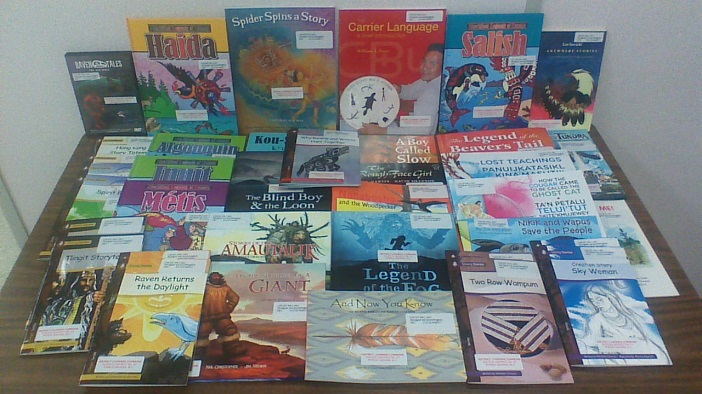 |
https://media3.sd57.bc.ca/display/208?t=447920 |
| Dakelh Ways of Knowing: Foraging, Secondary | 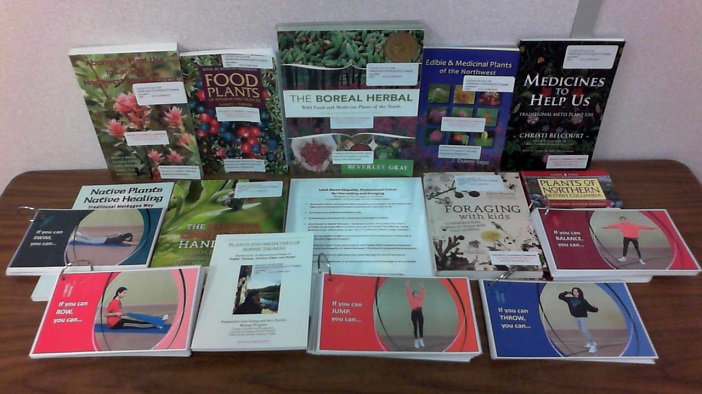 |
https://media3.sd57.bc.ca/display/208?t=490422 |
| Trickster Tales: Nanabozho Tales and Raven Tales | 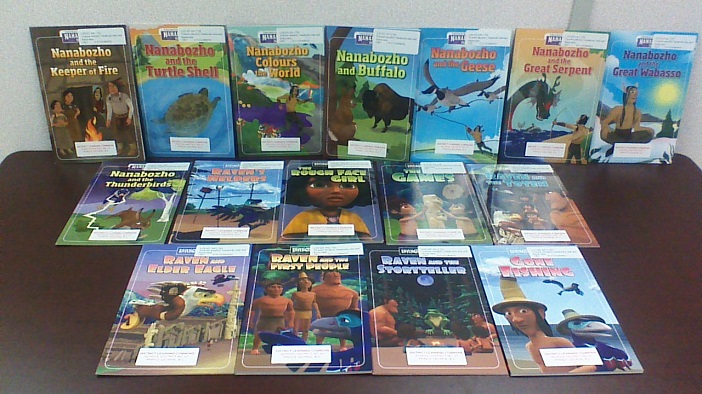 |
https://media3.sd57.bc.ca/display/208?t=439176 |
| Trickster Tales: Glooscap Tales and Wesakechak Tales | 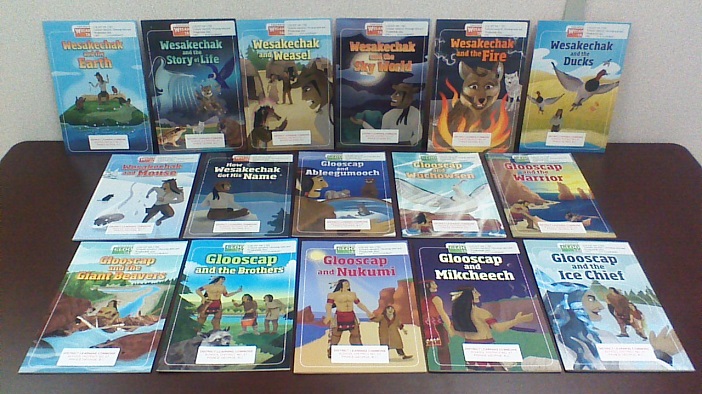 |
https://media3.sd57.bc.ca/display/208?t=439177 |
Web Resources
- INDIGENOUS CINEMA IN THE CLASSROOM (AGES 15+)These are stories about Missing and Murdered Indigenous Women, the Highway of Tears, Indigenous rights activism, violence against Indigenous Women, Indigenous stereotypes, racism, marginalized communities, community healing, the Oka Crisis, the Kahnawake tribe, Cree burial traditions, Indigenous pride, reconciliation, healing and recovery, residential schools, Two-Spirited people, salmon fishing rights, the Mi’kmaq people, historical perspective on contemporary Indigenous issues, village life in Puvirnituq, preserving cultures and traditions, suicide, addiction, substance abuse, co-existence of traditions and modernity, police violence, Saskatoon’s infamous “freezing deaths,” Indigenous women leadership, the Six Nations of the Grand River Reserve blockade, legal, land and human-rights issues, historical and contemporary understanding of relationships between Indigenous people and the Canadian government, the role of radio in a small community of Teetl’it Gwich’in, the Oka crisis and the now-infamous stand-off between the Mohawks, the Quebec police and the Canadian Army.
- Nadleh Whut'en - Our People, Our HistoryInformation about the Lejac Residential Scool
- Lejac, back from the grave (News Article)Residential school debris resurfaces, putting Indigenous industry at risk.
Useful for talking about news media and journalistic writing. - Media Smarts - Resources and Lessons for EFP 10This outcome chart contains media-related learning outcomes from the British Columbia, Grade 10 English First Peoples curriculum, with links to supporting resources on the MediaSmarts site.
- Snotty Nose Rez KidsIndigenous Hip-Hop Duo. Their music can be used for media analysis as part of New Media.
Physical Video Resources
| Title | Description | Subjects |
|---|---|---|
|
|
The Walk-A-Mile Film Project, which premiered on February 6, 2014 in Thunder Bay, is a collaboration of the City of Thunder Bay's Aboriginal Liaison Unit with Thunderstone Pictures, and is a series of 5 short documentary films that address subjects such as treaties, racism, violence against women, and the way forward. The films, which are the creation of award winning indigenous film maker Michelle Derosier, are each 10-15 minutes long and are designed to educate and encourage frank conversations in our community about the reality of the life and history of Aboriginal peoples both here and across Canada. To complement the Walk-A-Mile Film Project, the city of Thunder Bay also approached an indigenous curriculum writer to develop a facilitator's guide that will teach content via modules to four different audiences: elementary and high school, college and university, the workplace, and community groups. Each module contains supplementary teaching materials (quizzes, discussion guides, facilitator's speaking notes) that frame each film so they can do what they were intended: to teach, inform, engage, and to build bridges and relationships in a very effective and kind way |
Short films, Treaties, Racism, Violence against Women |
|
|
An adaptation of Richard Wagamese's award winning novel, this moving and important drama sheds light on the dark history of Canada's residential schools and the indomitable spirit of Indigenous people. |
Child abuse, hockey, Ojibwa, Residential Schools, Racism |
|
|
Based on the children's book Shi-shi-etko by Nicola Campbell, this beautiful story follows a young Aboriginal girl on the last four days before she is taken to residential school. This production is 12 min. and in Halq'emalem with English subtitles. |
Residential schools |
|
|
Indigenous elders Roy Thomas, Garnet Agneconeb, Ralph Johnson, Alice Littledeer, Eulalia Michano and Delaney Sharpe recount their experiences in residential schools. |
Residential schools |
|
|
In 1931, Molly and her younger cousins, Gracie and Daisy, were three half-caste children from Western Australia who were taken from their parents under government edict and sent to an institution, were taught to forget their families, their culture, and re-invent themselves as members of "white" Australian society. The three girls begin an epic journey back to Western Australia, travelling 1,500 miles on foot with no food or water, and navigating by following the fence that has been built across the nation to stem an over-population of rabbits. Rated PG for emotional thematic material. |
Australian Indigenous Peoples, Residential Schools |
Digital Video Resources
Note
Determination of "Indigenous Voice" is based on public information that identifies the author as Indigenous at the time of last update.


 Plays that focus on Indigenous issues.
Plays that focus on Indigenous issues.
















































